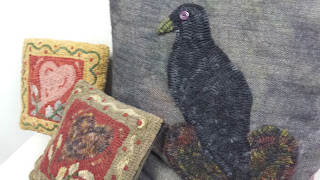Her rugs are in the tradition of Primitive Rugs. She told us that the other category of rug hooking is realistic style rug hooking. Both types of rug hooking are Folk Arts. Rugs are hooked by pulling narrow strips of wool fabric through a backing. In some areas of the country, they used wool yarn also in hooked rugs. The loops of the rug should lie together like ribbon candy.
Francie lives in an 1839 barn that has been turned into her home. She says the rugs fit in very well with her country decor. Here is Francie holding her beautiful rug that she hooked with the year 1839, since that is the year that her barn was built. She does use some of her rugs on the floor to walk on, and they look great and have held up very well. For a wall decoration, Francie recommends using a strip of carpet tack to hang your rug on the wall.
Here is a close-up picture of her beautiful 1839 rug.
Francie began her presentation with a poem called, "What Art Means to Me," by C. Valentine Kirby. She told us that the English brought over the tradition of rug-hooking on ships, and it helped pass the time on the long voyage. Rug hooking was also born of necessity in the United States. The rugs were used early as bed covers, which she said would have been warm but very heavy. They were used on bare floors or wooden floors. The oldest remaining hooked floor rug is from June 10, 1850. The rugs were made using natural American fibers of wool and flax. The rugs made with burlap have not lasted well. She said that burlap will eventually turn to dust. She said that linen is a good base fiber to use because it will last and also, if you take out a section of your rug hooking, you can easily close up the holes again by scraping the holes with your hook. She does not like using Monk's Cloth or a wool backing.
She had some holiday rugs to show us. Here is a lovely Christmas rug and a cute Drummer Boy rug.

We loved her Halloween rug.
Here are some more of her lovely rugs.
She had rug hooked pillows to show us. She said that no two rugs are alike. If two people make the same pattern, their rugs will look different. She said that even if she makes the same rug twice, each will be different. The two heart pillows were made by Doris and Francie, and you can see how different they look from each other, and both are so pretty. Doris' is the heart pillow on the left.
Francie showed us wool fabrics used in rug hooking. She had wide torn strips of wool used in one project, and she uses a big hook for wide strips. She uses plaid fabrics and showed us how the fabric looks in the hooked project compared to the plain fabric. To get an idea of how a plaid will look, you can roll up your plaid fabric tightly and then look at the edge of the roll of fabric. That's an idea of how the colors will look in your rug. She also had beautiful overdyed wool, which had splotches of color on it. She doesn't dye her own wool, but she said it can be dyed in casserole dishes or crock pots. She has cutters for cutting the strips of wool into various widths.
Francie uses various sizes of hooks, depending on the width of the fabric she is using. She showed us her favorite brand of hook, which was a Primitive size hook, and it had a round wooden handle. On the handle is a flat spot for your finger. She said the brand name of the hook is a Hartman hook.
She had two square wooden rug hooking stands for us to use to try rug hooking. She also demonstrated the technique for us. The stands have a strip of carding cloth on the edges to grip the backing fabric. The stands were portable stands to use on your lap. Her stand at home is a stand that swivels and tilts, which makes it convenient to hook in any direction.
You can buy patterns for rug hooking, and she showed us a pattern of a sailing ship that she will be starting soon. It is marked on the backing fabric.
Francie said that when you start hooking a rug, you start hooking the design first before hooking the background. She said that you want to be sure to have at least 2 rows of straight edging of loops around your piece. She hooks by first bringing up the tail of the fabric. She brings up a loop of fabric right next to the tail, and then skips a hole when bringing up the next loop. She said the first row is more difficult, but subsequent rows will help support the loops. She skips a hole between loops so the fabric won't be hooked too tightly. She worked the loops toward herself when demonstrating for us.
Francie mentioned some suppliers of rug hooking patterns and other supplies: Wooly Woolen in Independence, Missouri, and Prairie Road Designs. The Prairie Road Designs website is www.prairieroaddesigns.com and the Wooly Woolen website is www.woolywoolen.com . Doris' pillow design was from a booklet called "Needle Love."
Thank you, Francie, for a wonderful evening of rug hooking!








No comments:
Post a Comment